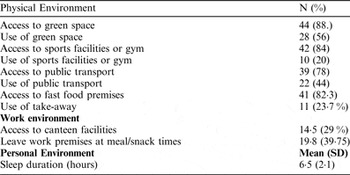Drivers of maternal adiposity are complicated and constitute more than just an energy imbalance( Reference Sui, Turnbull and Dodd 1 ). Personal choices and environmental factors also contribute to the rising rates of obesity. The obesogenic environment refers to factors that influence individuals to become excessively overweight( Reference Swinburn and Egger 2 ). They are classified as microenvironments (school, workplace, home, neighbourhood or macro-environments (education and health systems, government policies, societies attitudes and beliefs). We sought to assess the obesogenic microenvironment, sleep patterns and metabolic profiles in an overweight and obese pregnant cohort.
This is a prospective cohort study. Women with BMI >25 kg/m2 were recruited from the antenatal clinic and a lifestyle questionnaire assessing obesogenic risk factors, food behaviors and sleep patterns was administered. Serum samples taken in the first trimester were analyzed for fasting glucose, insulin, HOMA index and lipid profiles.
Fifty women were included in the analysis 36 (72 %) overweight, 14 (28 %) obese. Over 80 % of the group lived adjacent to green space ± gym facilities however all women reported having easy access to fast food outlets. More obese patients left their workplaces at lunch or break times during the week compared to overweight women 36·6. % vs. 42·9 % p = 0·037. The majority reported poor access to work canteen facilities (71·05 %). Obese pregnant women were also less likely to use public transport on their commute to work. Analysis of sleep duration revealed women in the sample slept on average 6·5 hours per night. Metabolic profiling showed significant higher levels of, insulin, c-peptide and HOMA index in the obese when compared to the overweight group.
This study has highlighted deficiencies in the physical, workplace and personal microenvironments that could contribute to maternal adiposity. Government, public health measures and local hospital policies should strive to limit convenience food outlets in the community, strive to improve work based environments and improve sleep hygiene amongst pregnant women. Metabolic derangement is also evident from early pregnancy and may impact on fetal growth and metabolism.



